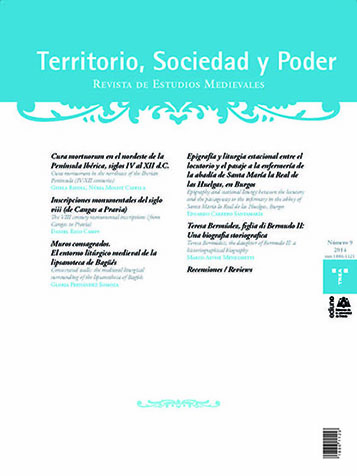Abstract
Resumen: En este artículo se hace un primer balance sobre la recuperación de la práctica epigráfica entre los cristianos de la Península Ibérica tras la invasión musulmana de 711 y se analizan en profundidad las cinco inscripciones más importantes y ambiciosos del siglo VIII —asociadas todas a la familia real asturiana—, tratando de situarlas en su contexto histórico, cultural y político. En primer lugar, se estudia la lápida de consagración de la iglesia de Santa Cruz en Cangas de Onís, encargada por Fávila en 737 y que aquí se interpreta desde una perspectiva litúrgica y en clave redentora, descartándose cualquier tipo de intencionalidad política. Justo lo contrario ocurre con la inscripción de la cripta de Santa Leocadia, atribuida por el padre Fita a Wímara (el hermano de Fruela I brutalmente asesinado por el propio monarca) y cuya realización se enmarca en la violenta lucha entre los dos hermanos por el dominio del territorio ovetense mediante la fundación de casas religiosas, entre otras estrategias. La segunda mitad del artículo se dedica a las tres inscripciones de la iglesia de Santianes de Pravia, en las que el autor no ve ninguna razón de peso para desechar su atribución al rey Silo y retrasar, en consecuencia, la construcción de Santianes al siglo X, como se ha propuesto recientemente. En el caso de confirmarse la adscripción de los tres textos a Silo, estaríamos ante el primer «programa epigráfico» de la España medieval y ante un ciclo equiparable a los coetáneos de Metz y Salerno, escritos ambos por Pablo Diácono y destacados precursores del renacimiento epigráfico que se produciría en Europa hacia el año 800.
Palabras clave: epigrafía medieval; inscripciones monumentales; arquitectura prerrománica; reino astur;Santa Cruz de Cangas de Onís; Oviedo; Santianes de Pravia; Fávila; Wímara; Silo.
Abtract: This article gives a first overview of the recovering of the epigraphic practice among Spanish Christians after the Islamic conquest of 711, and it discusses in depth the most important and ambitious inscriptions of the 8th century —all related to religious buildings and to the royal family of the Asturian kingdom—, trying to place them in their historical, cultural, and political contexts. Firstly, it is analyzed the dedication stone of Santa Cruz in Cangas de Onís, commissioned by Favila in 737. The inscription is interpreted here from a liturgical perspective and in a redemptive sense, discarding any kind of political intention. Precisely the opposite occurs in the inscription of Santa Leocadia, attributed by Father Fita to Wimara, the brother of Fruela I brutaly assassinated by the king himself. The inscription was made in the context of the fierce struggle between the two brothers to dominate the territory of Oviedo through the foundation of religious houses, among other strategies. The second half of the article adresses the three inscriptions of Santianes de Pravia, in which the author doesn’t see any compelling reason to dismiss their attribution to king Silo and to postpone, accordingly, Santianes construction to the 10th century, as recently proposed. In the event of confirming the ascription of the three texts to Silo, we would be facing the first «epigraphic program» of Medieval Spain and a cycle contemporary and comparable to those of Metz and Salerno, both written by Paul the Deacon and outstanding precursors of the epigraphic revival that occurred in Europe around 800 AD .
Keywords: Medieval Epigraphy; Monumental Inscriptions; Pre-Romanesque Architecture; Kingdom of Asturias; Santa Cruz in Cangas de Onís; Oviedo; Santianes de Pravia; Fávila; Wímara; Silo

